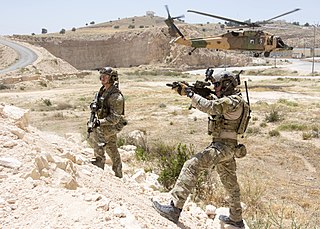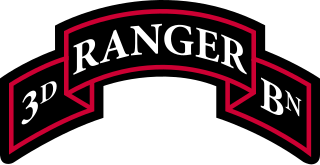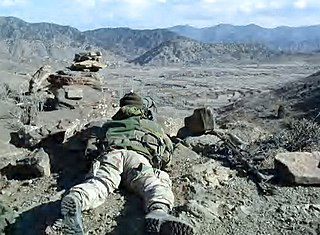
The United States Navy Sea, Air, and Land (SEAL) Teams, commonly known as Navy SEALs, are the U.S. Navy's primary special operations force and a component of the Naval Special Warfare Command. Among the SEALs' main functions are conducting small-unit special operation missions in maritime, jungle, urban, arctic, mountainous, and desert environments. SEALs are typically ordered to capture or kill high-level targets, or to gather intelligence behind enemy lines. SEAL team personnel are hand-selected, highly trained, and possess a high degree of proficiency in direct action (DA), and special reconnaissance (SR), among other tasks like sabotage, demolition, intelligence gathering, and hydro-graphic reconnaissance, training, and advising friendly militaries or other forces.

The Special Boat Service (SBS) is the special forces unit of the United Kingdom's Royal Navy. The SBS can trace its origins back to the Second World War when the Army Special Boat Section was formed in 1940. After the Second World War, the Royal Navy formed special forces with several name changes—Special Boat Company was adopted in 1951 and re-designated as the Special Boat Squadron in 1974—until on 28 July 1987 when the unit was renamed as the Special Boat Service after assuming responsibility for maritime counter-terrorism. Most of the operations conducted by the SBS are highly classified, and are rarely commented on by the British government or the Ministry of Defence, owing to their sensitive nature.

The Special Air Service Regiment, officially abbreviated SASR though commonly known as the SAS, is a special forces unit of the Australian Army. Formed in 1957 as a company, it was modelled on the British SAS with which it shares the motto, "Who Dares Wins". Expanded to a regiment in August 1964, it is based at Campbell Barracks, in Swanbourne, a suburb of Perth, Western Australia, and is a direct command unit of the Special Operations Command.

Australia joined a U.S.-led coalition in the Iraq War. Declassified documents reveal that the decision to go to war was taken primarily with a view to enhancing its alliance with the United States.

Special operations or special ops are military activities conducted, according to NATO, by "specially designated, organized, selected, trained, and equipped forces using unconventional techniques and modes of employment." Special operations may include reconnaissance, unconventional warfare, and counterterrorism, and are typically conducted by small groups of highly trained personnel, emphasizing sufficiency, stealth, speed, and tactical coordination, commonly known as special forces.

The Netherlands Marine Corps is the elite naval infantry corps of the Royal Netherlands Navy, one of the four Armed Forces of the Kingdom of the Netherlands. The marines trace their origins to the establishment of the Regiment de Marine on 10 December 1665, by the then grand pensionary of the Dutch Republic, Johan de Witt and famous Admiral Michiel de Ruyter. It is the second-oldest still-active marine corps in the world.

The Army Ranger Wing (ARW) is the special operations force of the Irish Defence Forces, the military of Ireland. In late 2023, it was reported that the unit was to be renamed the Ireland Special Operations Force (IRL-SOF). It is a branch of the Irish Army, it also selects personnel from the Naval Service and Air Corps. It serves at the behest of the Defence Forces and Government of Ireland, operating internally and overseas, and reports directly to the Chief of Staff. The ARW was established in 1980 with the primary role of counter terrorism and evolved to both special operations and counter-terrorism roles from 2000 after the end of conflict in Northern Ireland. The unit is based in the Curragh Camp, County Kildare. The 2015 White Paper on Defence announced that the strength of the ARW would be considerably increased due to operational requirements at home and overseas.

The Home Of Army Silent Unseen Paratroopers GROM Military Unit, simply known as the GROM Military Unit, is a Polish special forces unit and forms part of the Special Troops Command of the Polish Armed Forces. It is believed to consist of around 250 operatives plus support personnel. GROM is considered to be the most elite unit in the Polish Armed Forces.
The Special Emergency Response Team (SERT) was an elite police tactical unit of the Royal Canadian Mounted Police (RCMP). The SERT was formed in 1986 to provide a tactical capability to respond to major terrorist incidents throughout Canada. The unit was disbanded in 1993 when responsibility for counter terrorist response transferred from the RCMP to the Canadian Armed Forces (CAF).

The 3rd Ranger Battalion is the third of three Ranger Battalions belonging to the United States Army's 75th Ranger Regiment. It is currently based at Fort Moore, Georgia.
Canada's role in the Afghanistan War began in late 2001. Canada sent its first element of soldiers secretly in October 2001 from Joint Task Force 2, and the first contingents of regular Canadian Armed Forces (CAF) troops arrived in Afghanistan in January–February 2002. The operations were aimed at identifying and neutralizing Al-Qaeda members in that country and toppling the Taliban regime which was supporting international terrorism. Canada's role in the Afghan conflict grew in 2006 when Canadian troops relieved US forces in Kandahar province, taking command of the multinational brigade in the region during a major Taliban offensive.

The Special Forces Support Group (SFSG) is a special forces unit of the British Armed Forces. The SFSG was formed officially on 3 April 2006 to provide support to the Special Air Service, the Special Boat Service and the Special Reconnaissance Regiment on operations. It is a tri-service unit, composed of the 1st Battalion, The Parachute Regiment, a company of Royal Marine Commandos, and a flight (platoon) from the Royal Air Force Regiment.

Canadian Special Operations Forces Command is a command of the Canadian Armed Forces. It is responsible for all special forces operations that respond to terrorism and threats to Canadians and Canadian interests around the world.

Task Force K-Bar, originally the Combined Joint Special Operations Task Force-South (CJSOTF-South), was led by the United States and composed of special operations forces from seven countries. It undertook the first major ground deployment in the War in Afghanistan (2001–2021), operating from October 2001 to April 2002.

The 2nd Commando Regiment is a special forces unit of the Australian Army and is part of Special Operations Command. The regiment was established on 19 June 2009 when the 4th Battalion RAR (Commando) was renamed. It is based at Holsworthy, New South Wales. The 2nd Commando Regiment trains and has served with coalition special forces units, and is highly regarded by these units. The regiment has been involved in operations in East Timor, Iraq and Afghanistan, where it was used in a direct action warfighting role. It has also been involved in domestic security operations including the 2006 Commonwealth Games and the 2014 G20 Leaders Summit. The regiment is the Command's capability lead for strike and recovery.

The Marine Raider Regiment (MRR), formerly known as the Marine Special Operations Regiment (MSOR), is a special operations force of the United States Marine Corps, which is a part of Marine Corps Special Operations Command (MARSOC). Renamed for its predecessor, the World War II Marine Raiders, this unit is the principal combat component of MARSOC, which is the Marine Corps' contribution to the United States Special Operations Command (USSOCOM).

The U.S. Army Special Forces traces its roots as the Army's premier proponent of unconventional warfare from purpose-formed special operations units like the Alamo Scouts, Philippine guerrillas, First Special Service Force, and the Operational Groups (OGs) of the Office of Strategic Services. Although the OSS was not an Army organization, many Army personnel were assigned to the OSS and later used their experiences to influence the forming of Special Forces.

On 3 October 2014, Canadian Prime Minister Stephen Harper announced that he would put forth a motion to send forces to participate in the coalition for military intervention against ISIL by deploying combat aircraft. On 7 October 2014, the House of Commons approved of sending nine aircraft to join coalition airstrikes against ISIL in Iraq along with 69 special forces advisors to train the Iraqi government's military. The Canadian Armed Forces' contribution to the coalition against ISIL was later dubbed Operation Impact. On 30 March 2015, the House of Commons voted to extend the mission to targets in Syria. No additional forces were announced.

















